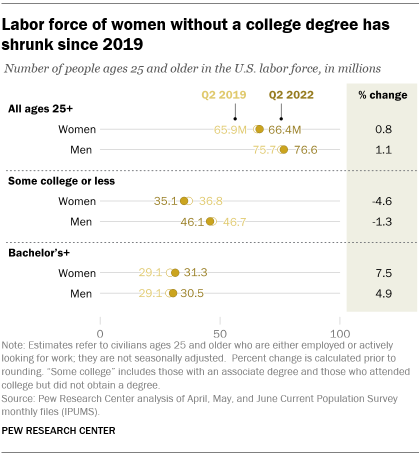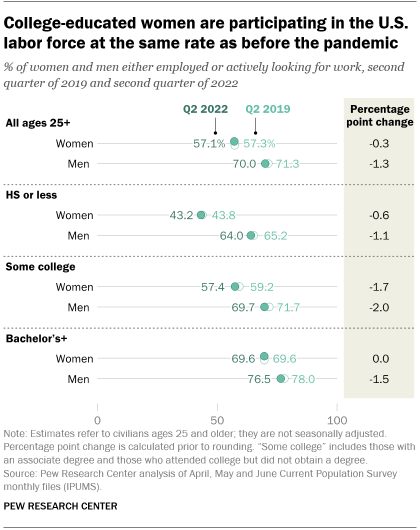Women have overtaken men and now account for more than half (50.7%) of the college-educated labor force in the United States, according to a Pew Research Center analysis of government data. The change occurred in the fourth quarter of 2019 and remains the case today, even though the COVID-19 pandemic resulted in a sharp recession and an overall decline in the size of the nation’s labor force.

Today, there are more women ages 25 and older with a bachelor’s degree or more education in the labor force than before the pandemic: 31.3 million in the second quarter of 2022, compared with 29.1 million in the same quarter of 2019. The number of college-educated men ages 25 and older in the labor force is also greater than before the pandemic – 30.5 million, up from 29.1 million – though their ranks have not increased as quickly as those of women.
The pandemic disproportionately impacted labor market activity for adults without a bachelor’s degree, especially among women. The number of women with some college or less education in the labor force has declined by 4.6% since the second quarter of 2019, compared with a smaller change among men with some college or less education (-1.3%).

The upshot of these disparate changes in the labor force by gender and education is that women have increased their representation in the college-educated labor force since 2019. At the same time, there has not been much change in the gender composition of the labor force that has some college or less education.
Changes in the composition of the U.S. population, along with changes in labor force participation, help account for these trends. The number of women and men in the labor force depends on the size of each group and the percentage of that group who are working or seeking work.
The number of women and men in the U.S. with at least a bachelor’s degree has increased since the second quarter of 2019. But the share of college-educated women who are in the labor force has not changed since before the pandemic, while the share of college-educated men who are working or looking for work has declined.

In the second quarter of 2022, the labor force participation rate for college-educated women was 69.6%, the same as in the second quarter of 2019. In contrast, men and most other educational groups now have lower rates of labor force participation than they did in the second quarter of 2019.
This shift in the college-educated labor force – as women now comprise a majority – comes around four decades after women surpassed men in the number of Americans earning a bachelor’s degree each year.

